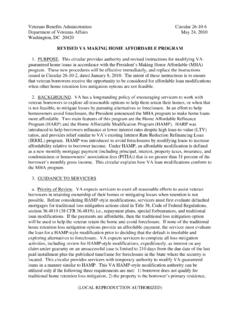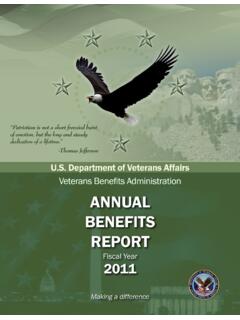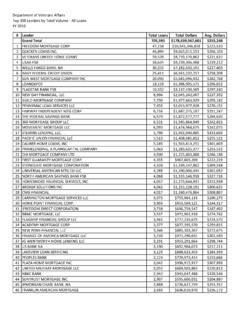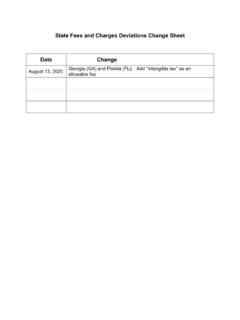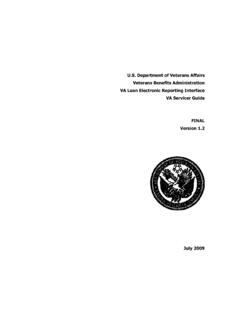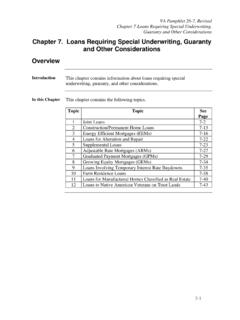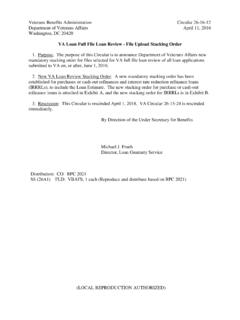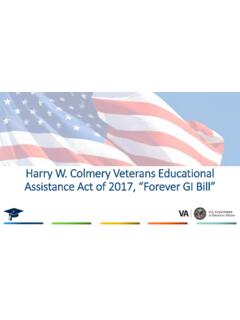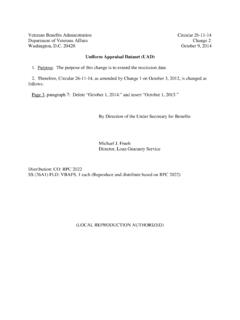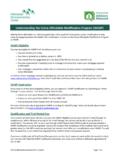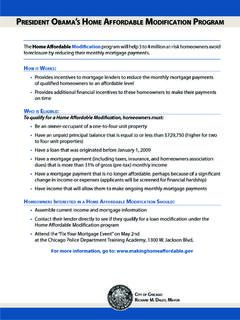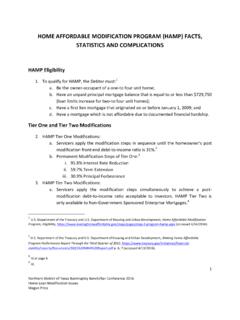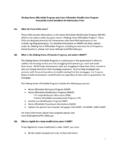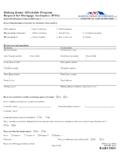Transcription of VA Making Home Affordable Program
1 Veterans Benefits Administration Circular 26-14-22 Department of Veterans Affairs September 2, 2014 Washington, DC 20420 VA Making home Affordable Program 1. Purpose. This Circular provides authority and instructions for modifying Department of Veterans Affairs (VA) guaranteed home loans in accordance with the President s Making home Affordable (MHA) Program . The intent of these instructions is to ensure that Veteran borrowers receive the opportunity to be considered for Affordable loan modifications when other home retention loss mitigation options are not feasible. 2. Background. VA has a longstanding policy of encouraging servicers to work with Veteran borrowers to explore all reasonable options to help them retain their homes, or when that is not feasible, to mitigate losses by pursuing alternatives to foreclosure.
2 In an effort to help homeowners avoid foreclosure, the President announced the MHA Program to make home loans more Affordable . Two main features of this Program are the home Affordable Refinance Program (HARP) and the home Affordable modification Program (HAMP). HARP was introduced to help borrowers refinance at lower interest rates despite high loan-to-value (LTV) ratios, and provides relief similar to VA s existing Interest Rate Reduction Refinancing Loan (IRRRL) Program . HAMP was introduced to avoid foreclosures by modifying loans to increase affordability relative to borrower income. Under HAMP, an Affordable modification is defined as a new monthly mortgage payment (including principal, interest, property taxes, insurance, and condominium or homeowners association fees (PITIA)) that is no greater than 31 percent of the borrower s monthly gross income.
3 This Circular explains how VA loan modifications conform to the MHA Program . 3. Guidance to Servicers. a. Priority of Review. VA expects servicers to exert all reasonable efforts to assist Veteran borrowers in retaining ownership of their homes or mitigating losses when retention is not possible. Before considering HAMP-style modifications, servicers must first evaluate defaulted mortgages for traditional loss mitigation actions cited in Title 38, Code of Federal Regulations, section ; , repayment plans, special forbearances, and traditional loan modifications which have no occupancy requirements. If the payments are Affordable , then the traditional loss mitigation option will be used to help the Veteran retain the home and avoid foreclosure. If none of the traditional home retention loss mitigation options provide an Affordable payment, the servicer must evaluate the loan for a HAMP-style modification prior to deciding that the default is insoluble and exploring alternatives to foreclosure.
4 VA expects servicers to complete all loss mitigation activities, including review for HAMP-style modifications, expeditiously, as interest on any claim under guaranty on an unsuccessful case is limited to 210 days from the due date of the last paid installment plus the published timeframe for foreclosure in the State where the security is located. This Circular provides servicers with temporary authority to modify VA-guaranteed loans in a manner similar to HAMP. (LOCAL REPRODUCTION AUTHORIZED) Circular 26-14-22 September 2, 2014 This VA HAMP-style modification authority can be utilized only if the following three requirements are met: 1) borrower does not qualify for traditional home retention loss mitigation, 2) the property is the borrower s primary residence ( , owner-occupied, as defined by the Department of Treasury (Treasury) for HAMP Tier I eligibility), and 3) the VA HAMP modification is agreed upon prior to the HAMP expiration date (currently December 31, 2015).
5 While Treasury restricts HAMP modifications to loans originated on or before January 1, 2009, VA will allow servicers to use HAMP-style modifications on any VA-guaranteed loan, subject to the requirement in 38 CFR (a) that prior VA approval must be obtained if less than 12 payments have been made since the loan closed. The VA guaranty amount on a HAMP-style modification will be calculated pursuant to 38 CFR (h), which could increase the maximum guaranty amount on the modified loan. b. Servicer Evaluates Loan for HAMP-style modification . Before evaluating whether a VA-guaranteed loan can be made Affordable with a HAMP-style modification , the servicer will first document its case notes with the reason why traditional loss mitigation options are not appropriate.
6 If the servicer was unable to contact the borrower to obtain financial information, or if the borrower declined to provide financial information, then it will not be possible to evaluate the loan for a HAMP-style modification . However, if verified financial information indicates insufficient income to justify a traditional loss mitigation option, then the servicer will use the financial information obtained to evaluate the possibility of a HAMP-style modification . Follow the Treasury guidelines on income consideration at , which may involve different treatment of unemployment, disability, or rental income than provided in standard VA underwriting protocols found in 38 CFR , and will utilize a debt to income standard rather than VA s traditional residual income underwriting.
7 (1) Calculate Target Affordable Payment. The gross monthly income will be multiplied by 31 percent to obtain the target HAMP-style modification total monthly payment. In accordance with Treasury Supplemental Directive 09-01, if net income or non-taxable income is provided, multiply that by to obtain the gross income figure. From the target (31 percent) total monthly payment, subtract the monthly escrow amount for property taxes, insurance, and condominium or homeowners association fees (TIA) to determine the target monthly principal and interest (PI) payment. (2) Estimate Modified Loan Balance. Calculate the estimated balance of the modified loan by including unpaid principal balance, accrued interest, and all reimbursable advances and expenses and fees other than late charges.
8 Because attorney fees and costs incurred in the foreclosure process are legitimate expenses that are typically chargeable to borrowers, and the Treasury guidelines preclude requiring the borrower to make any up-front cash contribution, VA will allow capitalization of foreclosure expenses in any HAMP-style modification . (3) Establish Modified Loan Terms. Using the standard Treasury HAMP waterfall, reduce the interest rate as low as 2 percent, in increments of .125 percent, to get as close as possible to the target monthly PI payment. If necessary, extend the term as long as 480 months from the date of modification , and then provide for principal deferment to achieve the target monthly mortgage payment. If none of these measures result in the target monthly PI payment, then servicers must pursue alternatives to foreclosure.
9 2 September 2, 2014 Circular 26-14-22 (4) Determine Feasibility of HAMP-style modification . VA does not require use of the Treasury NPV (net present value) model. However, each servicer must conduct its own analysis to decide whether it is more advantageous to retain a VA-guaranteed loan and execute a HAMP-style modification , or to refer the case to VA for refunding consideration (as described later), rather than exploring alternatives to foreclosure or proceeding with loan termination. c. Servicer Authority to Complete HAMP-style Modifications. If the loan meets HAMP eligibility requirements, this Circular grants the servicer prior approval to execute the modification pursuant to the HAMP guidelines located at with the following exceptions: (1) Standard VA servicer incentives apply.
10 (2) VA-guaranteed home loans are not eligible for any MHA incentives issued by Treasury at this time. (3) VA will not pay servicer incentives for any modification completed on a current loan. (4) VA will not pay borrower Pay-for-Success incentives. (5) Servicer Participation Agreements are not required. d. modification of Current Loans. Current VA loans may not be solicited for HAMP-style modification , as they should be considered for refinancing using VA s IRRRL Program . However, if a Veteran borrower contacts a servicer to advise of imminent danger of default, the loan may be evaluated under the HAMP guidelines if a traditional modification will not make payments Affordable . modification of current loans requires VA prior approval. e.
